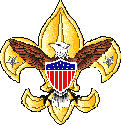 Lifesaving* Lifesaving*
Requirements
2002
- Before doing requirements 2 through 15
- Complete
Second Class
requirements 7a through 7c and
First Class
requirements 9a through 9d.
- Second Class requirements 7a through 7c
- Tell what precautions must be taken for a
safe swim.
- Demonstrate your ability to jump feet-first
into water over your head in depth, level off and swim 25 feet on
the surface, stop, turn sharply, resume swimming, then return to
your starting place.
- Demonstrate water rescue methods by
reaching with your arm or leg, reaching with a suitable object, and
by throwing lines and objects. Explain why swimming rescues should
not be attempted when a reaching or throwing rescue is possible, and
explain why and how a rescue swimmer should avoid contact with the
victim.
- First Class requirements 9a through 9c:
- Tell what precautions should be taken for a
safe trip afloat.
- Successfully complete the BSA swimmer test.
- With a helper and a practice victim, show a
line rescue both as tender and as rescuer. (The practice victim
should be approximately 30 feet from shore in deep water).
- Swim continuously for 400 yards using each of
the following strokes in a strong manner for at least 50 continuous
yards: front crawl, sidestroke, breaststroke, and elementary backstroke.
- Explain the following:
- Common drowning situations and how to prevent
them.
- How to identify persons in the water who need
assistance.
- The order of methods in water rescue.
- How rescue techniques vary depending on the
setting and the condition of the person needing assistance.
- Situations for which in-water rescues should
not be undertaken.
- Demonstrate "reaching" rescues using various
items such as arms, legs, towels, shirts, paddles, and poles.
- Demonstrate "throwing" rescues using various
items such as lines, ring buoys, rescue bags, and free-floating supports.
Successfully place at least one such aid within reach of a practice victim
25 feet from shore.
- Show or explain the use of rowboats, canoes, and
other small craft in performing rescues.
- List various items that can be used as rescue
aids in a non-contact swimming rescue. Explain why buoyant aids are
preferred.
- Perform the following equipment-based rescues
for a conscious practice subject 30 feet from shore. Use a proper
entry and a strong approach stroke. Speak to the subject to determine his
condition and to provide instructions and encouragement.
- Present a rescue tube to the subject, release
it, and escort the victim to safety.
- Present a rescue tube to the subject and use it
to tow the victim to safety.
- Present a buoyant aid other than a rescue tube
to the subject, release it, and escort the victim to safety.
- Present a buoyant aid other than a rescue tube
to the subject and use it to tow the victim to safety.
- Remove street clothes in 20 seconds or less and
use a non-buoyant aid, such as a shirt or towel, to tow the subject to
safety. Explain when it is appropriate to remove heavy clothing before
attempting a swimming rescue.
- Explain the importance of avoiding contact with
an active victim and describe lead-and-wait tactics.
- Perform the following non-equipment rescues
for a conscious practice subject 30 feet from shore. Begin in the
water from a position near the subject. Speak to the subject to determine
his condition and to provide instructions and encouragement.
- Provide a swim-along assist for a calm,
responsive, tired swimmer moving with a weak forward stroke.
- Perform an armpit tow for a calm responsive,
tired swimmer resting with a back float.
- Perform a cross-chest carry for an exhausted,
passive victim who does not respond to instructions to aid himself.
- In deep water, show how to escape from a victimís
grasp on your wrist. Repeat for front and rear holds about the head and
shoulders.
- Perform the following rescues for an
unconscious practice subject at or near the surface 30 feet from
shore. Use a proper entry and strong approach stroke. Speak to the subject
and splash water on him to determine his condition before making contact.
Remove the victim from the water, with assistance if needed, and position
for CPR.
- Perform an equipment assist using a buoyant
aid.
- Perform a front approach and wrist tow.
- Perform a rear approach and armpit tow.
- Describe how to respond if a victim submerges
before being reached by a rescuer, and do the following:
- Recover a 10-pound weight in 8 to 10 feet of
water using a feet-first surface dive.
- Repeat using a headfirst surface dive.
- Demonstrate knowledge of resuscitation
procedures:
- Describe how to recognize the need for rescue
breathing and CPR.
- Demonstrate proper CPR technique for at least 3
minutes using a mannequin designed to simulate ventilations and
compressions.
- Demonstrate management of a spinal injury:
- Explain the signs and symptoms of a spinal
injury
- Support a face up victim in calm, shallow
water.
- Turn a subject from a facedown to a face-up
position while maintaining support.
- Show that you know first aid for other injuries
or illnesses that could occur while swimming or boating, including
hypothermia, heat reactions, muscle cramps, sunburn, stings, and
hyperventilation.
|
 Lifesaving*
Lifesaving*
.jpg)
